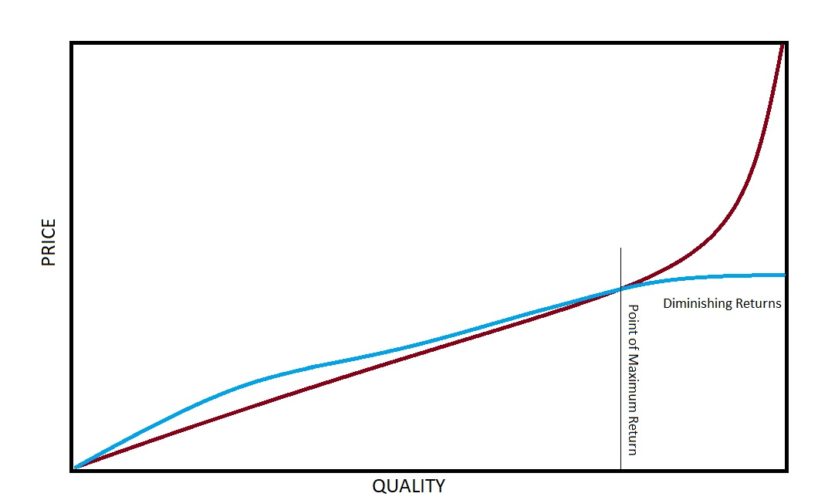By Well Sewn Staff
In economics, there is a theory called the Law of Diminishing Returns, and this is a term that you will hear used often here at Well Sewn. While diminishing returns, as a theory, is generally applied to production methods, it can be applied to a large swatch of other aspects of life, as well. In this case, we are going to see how it applies to the quality of the goods we purchase.
Using a simplistic example – and forgiving me for the very generalized figures – let’s consider a car purchase. A used car is, at its most basic, a car, and we will assume it is reasonably functional, and gets you from point A to point B, safely. Now, as an alternative, you consider a new car purchase instead, and let’s say a Kia, which costs $3,000 more than the used car. You are getting far more than $3,000 in value by moving up to the Kia; you are getting a car with no existing wear, no unknown past mechanical difficulties, a warranty, likely newer safety features, etc. And, as we will assume with all of the other cars, it will still get you from point A to point B. So you’re getting excellent return on that $3,000 investment.
What about, as an alternative from the Kia, a Hyundai, which costs $5,000 more than the Kia does. Again, it’s more expensive, but again, you’re getting a good return on that investment. A higher quality build, more safety features, likely more convenience features, a better warranty, perhaps included maintenance. You’re still at, or above, as I’ll show later, the curve for diminishing returns.
Now, considering yet another alternative, this time, a Mercedes-Benz. $10,000 more than the Hyundai. This one likely seems, if you started out considering a used car, to be a harder pill to swallow, but generally speaking, you are still getting a decent return on your investment, you are getting $10,000 more in value – you’re “getting your money’s worth”. The Mercedes is likely to have substantially higher build quality, more mechanical complexity and redundancy, far more technological advancement, cutting edge safety features, and, of course, it is a luxury vehicle, and the sales experience that comes with that.
But what if we go a step further, and consider a Bentley, which costs $100,000 more than the Mercedes. I absolutely love Bentley cars, I used to import them, and they are a level of refinement and luxury that is nearly unbelievable. Is it a better car than the Mercedes? Absolutely, 100%. Is it more refined, more luxurious? Of course. More comfortable, more advanced technology, faster? Check, check, and check. Does it present a more refined image? Clearly! Is it $100,000 higher in quality than the Mercedes? No, it is not… and now we have reached the point of diminishing returns, because you are no longer getting as much in return for the investment you are putting in. You are no longer “getting your money’s worth.”
In the example above, if I were to be advising someone, I would tell them that the Bentley is nice, but simply isn’t a good choice for their money. They would get the most for their money – maximizing their returns – by getting the Mercedes, but would also get an excellent value if they thought it reasonable to get the Hyundai. They would want to consider their needs, budget, and choices, and balance those things out to decide what is best for them between the two. I wouldn’t lead them astray to something overly expensive, no matter how much I myself like it, when it does not maximize their return on investment, and I certainly would never recommend something to them that is cheap or low quality.
 In the chart to the right, price is charted in red, and quality is charted in blue. You can quickly and easily see that, beyond the point where the lines cross over each other, quality is still improving, but not nearly at the same pace as price. Generally speaking, that point of maximum return is where we at Well Sewn would want to guide you, at the high end. Beyond that, it’s simply not in your best interest. We want to help you find the best for you, wherever on the scale your budget may be, and how to make the most of it!
In the chart to the right, price is charted in red, and quality is charted in blue. You can quickly and easily see that, beyond the point where the lines cross over each other, quality is still improving, but not nearly at the same pace as price. Generally speaking, that point of maximum return is where we at Well Sewn would want to guide you, at the high end. Beyond that, it’s simply not in your best interest. We want to help you find the best for you, wherever on the scale your budget may be, and how to make the most of it!
Overall, the ideal, savvy move as a buyer is be right at that point where you are getting the most quality possible for your money, before you start to see diminishing returns – that is the point where you are maximizing value, maximizing return on investment. At the very least, you should endeavor to be high on the curve and above it, if possible. This plays a critical role in the concept of the advice we offer at Well Sewn, which is to help people maximize their return on investment when choosing what to purchase. Anybody can recommend something simply because it expensive, but clearly, just because it is expensive does not mean you’re getting the most for your money. And remember the adage about a fool and his money… we endeavor to help create cultured minds and connoisseurs, not fools!



